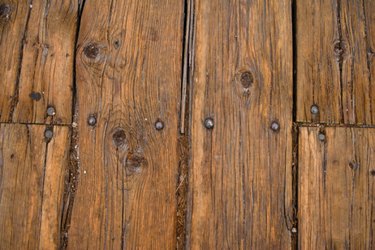Things You'll Need
Vacuum
Tack cloth
Broom
Terrycloth dry mop
Polyurethane
Paint tray
Paintbrush or paint roller
Sandpaper, 280-grit or finer

The grain patterns, bumps and knots in hardwood and softwood floorboards create a varied and textured look missing from floating wood laminate floors. But floorboards lack the protective coating found on laminate flooring and need to be sealed to ensure longevity. Sealing floorboards involves the use of polyurethane, a thick, clear-coating substance that forms a protective barrier. In addition to protecting the wood, sealing floors also makes clean-up a snap -- just wipe up spills with a damp rag.
Step 1
Prepare the floor. Sealing typically takes place after you've sanded and stained a floor. Vacuum to remove any loose dust, and then wipe the floorboards with a tack cloth to collect any remnants. Sweep and dry mop the floor if you're sealing the floorboards without sanding and staining it first.
Video of the Day
Step 2
Pour polyurethane into a paint tray.
Step 3
Spread the polyurethane over the floorboards, using a paintbrush or paint roller, and applying it as you would any other paint. Start in one corner of the room and work your way out, painting along the grain of the floorboards. Avoid painting yourself into a corner.
Step 4
Let the polyurethane dry completely, which typically takes six to eight hours. Avoid walking on the polyurethane while it's drying.
Step 5
Roughen the surface of the polyurethane by gently sanding the sealer with 280-grit or finer sandpaper. Go over the surface lightly and don't remove much.
Step 6
Vacuum up the sanding residue. Wipe the floor with a tack cloth afterward to pick up dust.
Step 7
Apply a second coat of polyurethane, using the same techniques used for the first coat. Allow the sealer to dry completely.
Tip
The first coat of polyurethane can be thinned up to 50 percent by stirring in water, according to "Popular Woodworking Magazine." The second coat should be applied at full strength. If bubbles appear, brush the area again to work them out of the clear coating.
Warning
Avoid wet mopping the floorboards before sealing. Excessive water and wet mopping can make floorboards swell and splinter.
Video of the Day